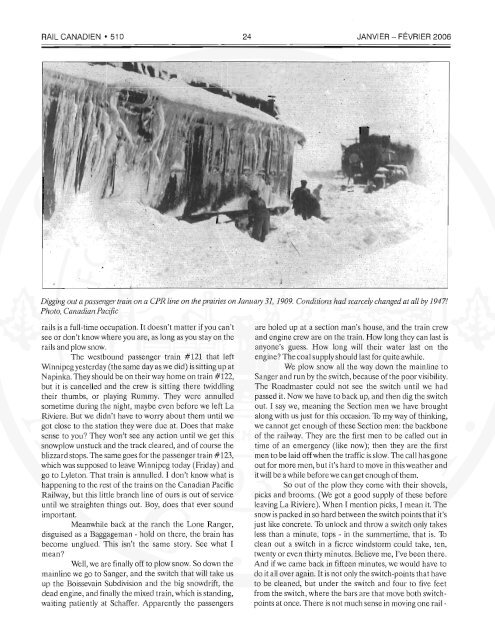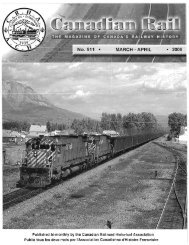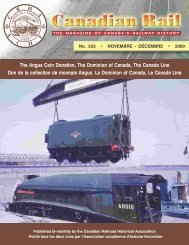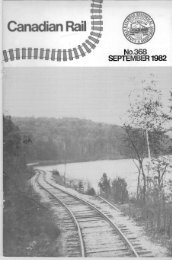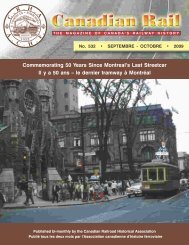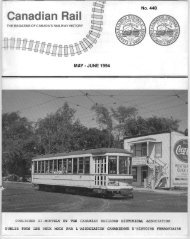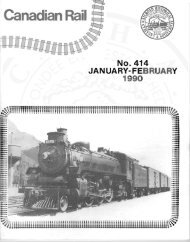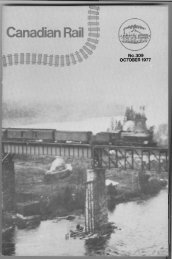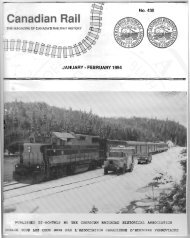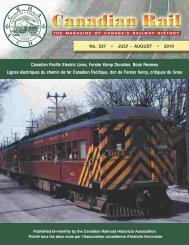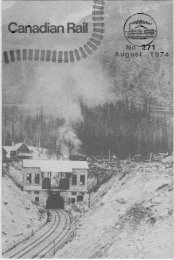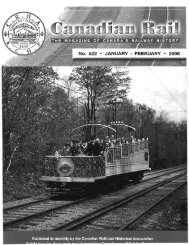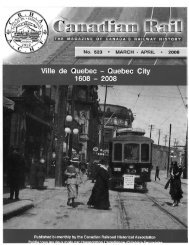Canadian Rail_no510_2006 - Le musée ferroviaire canadien
Canadian Rail_no510_2006 - Le musée ferroviaire canadien
Canadian Rail_no510_2006 - Le musée ferroviaire canadien
Create successful ePaper yourself
Turn your PDF publications into a flip-book with our unique Google optimized e-Paper software.
RAIL CANADIEN • 510 24 JANVIER - FEVRIER <strong>2006</strong><br />
Digging out a passenger train on a CPR line on the prairies on Janumy 31, 1909. Conditions had scarcely changed at all by 19471<br />
Photo, <strong>Canadian</strong> Pacific<br />
rails is a full-time occupation. It doesn't matter if you can't<br />
see or don't know where you are, as long as you stay on the<br />
rails and plow snow.<br />
The westbound passenger train #121 that left<br />
Winnipeg yesterday (the same day as we did) is sitting up at<br />
Napinka. They should be on their way home on train #122,<br />
but it is cancelled and the crew is sitting there twiddling<br />
their thumbs, or playing Rummy. They were annuJled<br />
sometime during the night, maybe even before we left La<br />
Riviere. But we didn't have to wony about them until we<br />
got close to the station they were due at. Does that make<br />
sense to you? They won't see any action until we get this<br />
snowplow unstuck and the track cleared, and of course the<br />
blizzard stops. The same goes for the passenger train #123,<br />
which was supposed to leave Winnipeg today (Friday) and<br />
go to Lyleton. That train is annulled. I don't know what is<br />
happening to the rest of the trains on the <strong>Canadian</strong> Pacific<br />
<strong>Rail</strong>way, but this little branch line of ours is out of service<br />
until we straighten things out. Boy, does that ever sound<br />
important.<br />
Meanwhile back at the ranch the Lone Ranger,<br />
disguised as a Baggageman - hold on there, the brain has<br />
become unglued. This isn't the same stOlY. See what I<br />
mean?<br />
Well, we are finally off to plow snow. So down the<br />
mainline we go to Sanger, and the switch that will take us<br />
up the Boissevain Subdivision and the big snowdrift, the<br />
dead engine, and finally the mixed train, which is standing,<br />
waiting patiently at Schaffer. Apparently the passengers<br />
are holed up at a section man's house, and the train crew<br />
and engine crew are on the train. How long they can last is<br />
anyone's guess. How long will their water last on the<br />
engine? The coal supply should last for quite awhile.<br />
We plow snow all the way down the mainline to<br />
Sanger and run by the switch, because of the poor visibility.<br />
The Roadmaster could not see the switch until we had<br />
passed it. Now we have to back up, and then dig the switch<br />
out. I say we, meaning the Section men we have brought<br />
along with us just for this occasion. To my way of thinking,<br />
we cannot get enough of these Section men: the backbone<br />
of the railway. They are the first men to be called out in<br />
time of an emergency (like now); then they are the first<br />
men to be laid off when the traffic is slow. The call has gone<br />
out for more men, but it's hard to move in this weather and<br />
it will be a while before we can get enough of them.<br />
So out of the plow they come with their shovels,<br />
picks and brooms. (We got a good supply of these before<br />
leaving La Riviere). When I mention picks, I mean it. The<br />
snow is packed in so hard between the switch points that it's<br />
just like concrete. To unlock and throw a switch only takes<br />
less than a minute, tops - in the summertime, that is. To<br />
clean out a switch in a fierce windstorm could take, ten,<br />
twenty or even thirty minutes. Believe me, I've been there.<br />
And if we came back in fifteen minutes, we would have to<br />
do it all over again. It is not only the switch-points that have<br />
to be cleaned, but under the switch and four to five feet<br />
from the switch, where the bars are that move both switchpoints<br />
at once. There is not much sense in moving one rail-


